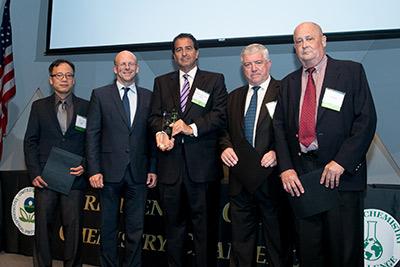Presidential Green Chemistry Challenge: 2015 Greener Reaction Conditions Award
Soltex (Synthetic Oils and Lubricants of Texas)
A Novel High Efficiency Process for the Manufacture of Highly Reactive Polyisobutylene Using a Fixed Bed Solid State Catalyst Reactor System
 Jim Jones, Former Assistant Administrator of EPA’s Office of Chemical Safety and Pollution Prevention, with awardees from SoltexInnovation and Benefits: SOLTEX (Synthetic Oils and Lubricants of Texas) in Houston, Texas, is being recognized for developing a new chemical reaction process that eliminates the use of water and reduces hazardous chemicals in the production of additives for lubricants and gasoline. If widely used, this technology has the potential to eliminate millions of gallons of wastewater per year and reduce the use of a hazardous chemical by 50 percent.
Jim Jones, Former Assistant Administrator of EPA’s Office of Chemical Safety and Pollution Prevention, with awardees from SoltexInnovation and Benefits: SOLTEX (Synthetic Oils and Lubricants of Texas) in Houston, Texas, is being recognized for developing a new chemical reaction process that eliminates the use of water and reduces hazardous chemicals in the production of additives for lubricants and gasoline. If widely used, this technology has the potential to eliminate millions of gallons of wastewater per year and reduce the use of a hazardous chemical by 50 percent.
Summary of Technology: Polyisobutylene (PIB) is used in the production of dispersants and detergents for lubricants and gasolines. PIB is an isobutylene polymer containing one double bond per polymer molecule. In high-reactive PIB, the double bond is at or near the end of the polymer chain in a branched position making the product more reactive. When the double bond is located at internal positions in the backbone of the polymer, PIB is less reactive, creating low-reactive PIB.
Traditional processes to make high-reactive PIB use a liquid polymerization catalyst. The catalyst is continually fed to the reactor and mixed with isobutylene monomer. The liquid catalyst is toxic and corrosive, and requires special handling systems and procedures to avoid exposure and vapor release. As the reaction mixture leaves the reactor, the catalyst must be immediately neutralized to stop the reaction and separated. The separation process involves washing the neutralized catalyst complex from the reaction mixture with copious amounts of water to remove all catalyst residues. Trace amounts are corrosive to subsequent processing steps and detrimental to product quality and stability. Neutralized catalyst cannot be recycled. This process substantially increases plant capital investment, increases operating costs, and generates approximately as much wastewater as product.
Soltex’s new process is based on a novel solid catalyst composition using a fixed-bed reactor system. A solid catalyst, in the form of a bead or other convenient geometrical shapes and sizes, is packed into a vessel to form a stationary, completely contained bed. Isobutylene monomer is fed to the reactor at a controlled rate and passes over the solid catalyst allowing the polymerization to occur. The polymer mixture exits the reactor at the same controlled rate. This reactor effluent contains minimal catalyst residues, therefore no subsequent catalyst separation or water wash is required.
The Soltex process, using this solid catalyst composition, produces high yields of high purity product with significantly lower catalyst usage. It is a simplified, highly efficient operation with substantially reduced capital investment, low operating and catalyst costs, and no water wash generation.
Other resources:
Note: Disclaimer
Return to the list of all winners including the 2015 Award Winners.
